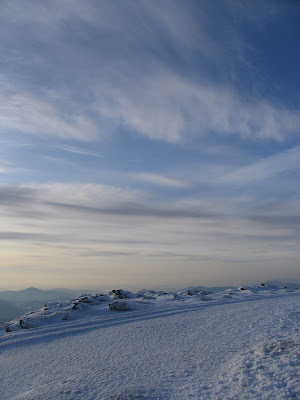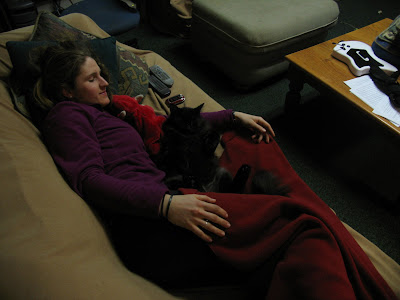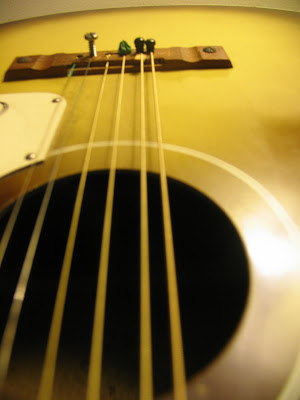
Sunrise over wildcat and the peaks to the southeast of the summit. One of many great sunrises we had this week. In the morning instead of my ritual shovelling, I would run out in my slippers and fleece to get some shots of the colors. The nice, still weather allowed for very little blowing snow and hardly any precipitation --a welcome thing, although it did get me a little less exercise this week.
The weather this week wasn't particularly interesting, but certainly beautiful. After a day of freezing rain, we had high pressure, sunny weather through the rest of our time up. This made for several sunrises and sunsets, and some great stars as well. We didn't really get out to watch the stars as a group this time, but we had several overnight trips that were happy to see them. The winds from the west and northwest also created some fantastic lenticular clouds off of the summit cone, including one that persisted for several days on and off. These were especially nice in the pink and orange light of the sunrise. The high pressure systems also made the air very stable, creating a visible boundary layer on the horizon. This was pretty significant to me, since I've been studying the movement of this layer.
I went hiking with Brian (my first time hiking with him) to the summit of Monroe, which is just above Lakes of the Clouds. I'd never summited it before, and it was definitely worth the somewhat painful climb straight up the side. We had some really great food this week thanks to our volunteers, Sue & Mike Zlogar. Mike gave me some recipes for one of our family traditions, Potica, and also for sourdough pancakes.
Between meals, I also managed to get some more work done on my research --I started running the Stability Time Series model for all summer days for the study years to find average boundary layer heights for each year and month. I also looked more into using the particle dispersion model rather than the simple trajectory to find the source of the pollutants, and started preparing for those runs. This data is going to be difficult to deal with because there will be more of it, and it will need to be organized quite differently in order to be interpreted. I found out earlier this week that, despite my small contribution to the paper, I'm going to be a co-author in the first of Georgia's articles on this PM work. Very cool!!
Back down off the mountain, we felt rain as soon as we got out of the cat. It was refreshing to feel the familiar little drops falling on my face, and it's nice to once again see running waterways and trees. The week of warm weather has brought the "mud season" on earlier than the local obs people would expect, but I'm happy to see it come. I enjoyed a little puddle stomping and sitting by the creek at the base before we went out for a visit to a sugar shack. Chris of the State Park up on the summit built his own little sugar shack (for distilling maple syrup), and has been running for the past few days. The place smells amazing, and he showed me around the machinery a bit.
The river in front of our house is also flowing nicely, and provides a constant swish and humm when you're anywhere near the windows. With the sun shining and the water running, the conditions are perfect for a good run and a little guitar playing.

Tip Top House (the oldest remaining building on the summit), the top of the obs tower, and the summit sign

The North Presidentials and Nelson Crag Trail sign from the front entrance of the building, taken around sunrise. The mountains pictured are Adams (left) and Madison (right).

Whispy low cirrus (maybe?) over the summit, looking ESE. Also taken at sunrise.

An undercast sunrise, looking over Wildcat mountain.

The top of the Tuckerman Ravine Trail, which leads down the summit cone on the southeast side to the Lion's Head Trail and Tuckerman Ravine. Tuck's is a pretty famous spot for skiing and hiking, mostly, as I understand, because of its classic bowl shape.

This is a piece of the electrical cord that brings us our power. It was put in a bit over a year ago. You can see the huge amount of copper that's in it, and all the insulation. The wire runs about three miles along the Cog Railroad tracks, and seems to have survived so far. We've been out of power once while I've been up here, which just means we have to switch to using the kerosene generators that were previously used fulltime.

Stairs leading down the Tuckerman Ravine Trail top. Closed for the winter, but nice to look at in the snow.

On Wednesday morning, Marty decided to venture outside. He went up on his own, which hasn't happened since I've been here. He has been out before in the winter, but doesn't usually like the snow on his paws. This time, he roamed around for a few minutes and tried to clmb up the southwest side of the obs deck, which has ice-covered rocks all up it, but slid all the way down again with only his little claws to keep him in place. I must say, despite his lack of skillz in the snow, he does look nice.

Here's a shot of his not-so-successful climb up the icy rocks. Apparently the presence of a hiker scared him into the climb, and the whole thing made for some interesting and awkward shots of him...

Another good thing about a calm week: no shovelling! I barely had to shovel at all. The ice on the obs deck never actually came off --there was a good little chunk of it up there the whole week. As for this pain-in-the-neck emergency exit, however --I shovelled it once.

The melting left some great patterns in the rime ice as well. This shot is a bit after sunrise, looking over the southeast side of the obs deck.

This is the Pitot tube, which measures wind speed at the top of the tower. It's usually used on airplanes, but in this case, as Brian says, "the wind blows through us rather than it blowing through the wind." (He does shows over the video equipment every few days in which he explains all the weather equipment and such.) The Pitot is heated, but it still gets clogged up when we have particularly icy and windy conditions. This means we have to go pump out the tubes that connect to it in the tower, and "de-ice" it (hit the post holding it up with a crow-bar) every hour or so.

A shot of the North Presis, but this time with the distinct boundary layer in the background.

A mountain shadow just before sunset --the mountain is big enough to actually cause a shadow to form from our perspective. Pretty cool, and this one was very distinct because of the cloudless conditions.

Looking southward down to Monroe (the point peak). This is where Brian and I hiked to this week --the photo was taken the following morning. You can also see the Lakes of the Clouds hut if you look close enough, at the base of the Monroe summit cone on the right.

This isn't the best picture ever of them, but here are Mike and Sue Zlogar of Amhurst, Mass., our cooks for the week. They were very successful in corned beef and cabbage, as well as big breakfasts every morning and some delicious-looking desserts.

A self portrait against the North Presis, taken from the top of the tower.

Another of Marty scrambling on up the side of the obs deck.

Looking upward from the base of the obs deck to the tower on the south side. Very little snow after a week of spring weather!

This was a very interesting lenticular that stayed for over 24 hours this week. I think you can almost see the shape of the summit in it --the winds from the west and northwest caused it to form. It would dissipate, then half would appear, or it would get little whispies along the top --really neat to see it evolve and change.

Some more lenticulars hanging off to the west of the summit. This was at sunrise --possibly the first we saw this week.



Jim of State Park, walking over to Yankee Building to check on the equipment and building temperature, etc. The State people do this twice a day. Jim's a really nice guy, and has been working at the summit since last November. Favorite movies: Gold Member and Harold & Kumar Go to White Castle.

This is my little intern corner, where it all happens. It's really nice to have two extra large screens to work with, and the system is really fast. We also have plenty of toys around (you can see the reindeer up on the light base), and the observers and I frequently throw the little plastic lizards and other items at each other to keep from falling asleep during the day.

A photo of the North Presis, with icicles and glaze ice chunks on the base of the tower deck in the foreground.

Footsteps in the nicely coated snow. You can see that people don't sink in far, and there's a bit of a crunch when you walk. In a lot of places, especially on hills, it's pretty much impossible to walk without crampons.

This is the top of Crawford Path, part of the Appalachian Trail. It's what we took down to Monroe, and it also goes down to the Lakes of the Clouds. As I think I mentioned in an earlier blog, it's the oldest maintained trail like this in the country.

This is Brian, who thinks he looks cool in his "blades" and Penn State hat. He thinks.

Brian slinging out on the obs deck. They have to do it in the shade for continuity --the temperature of the instrument needs to consistently measured either in the shade or sun so that the ambient temperature isn't altered by that change. They generally walk around a bit after slinging to see the cloud cover and estimate visibility.

Brian sleeping with the kitty in the observer office. This is really unusual to see, as the cat doesn't really cuddle. Brian, however, is a napper.

Here's a good shot of the boundary layer and some serious haze right around us. This pic is looking WNW toward Bretton Woods ski area on the left, and the foothills of the N Presis on the right.

Here's the spout for the AIRMAP (monitored air pollutants up until this year, when funding ran out) project. You can also see the boundary layer on the horizon, off to the west. The intake here is on the tower.

Some hikers coming up the Tuckerman Ravine Trail, with the top of Tuck's in the background to the left. You can also see Attitash and Bear Peak in the back (the first place I ever skiied!) and the Mount Washington Valley to the left-center there.

Here's "Whitey". She's our new snow cat, complete with DVD player and cushy, individual seats. She's been having some issues lately, but we always root for having her come up instead of the "Short Bus." Not that we don't love the Short Bus, but we prefer to have Scrubs to keep us occupied on the hour+ trip down.

This is the Sttate Park and rotunda side of the building from the fron entrance. That pain-in-the-neck emergency exit that I shovel is at the bottom of the building on the left where all the ruffled snow is. Off to the right are the N Presis.

A shot of the sunset from the tower. This one was a bit too cloudy to see much, but still quite beautiful. It's been a bit of a ritual to come up and watch it with Mike and the volunteers --hopefully there will be many more in the next few weeks.

And last but not least, a nice shot of me bugging Ryan. I wrote a comment this week about what I do while I'm on the summit, and had Brian take this shot to include. Ryan's face is priceless. I know he was truly annoyed with me for having it taken, but he did an excellent acting job nonetheless.























